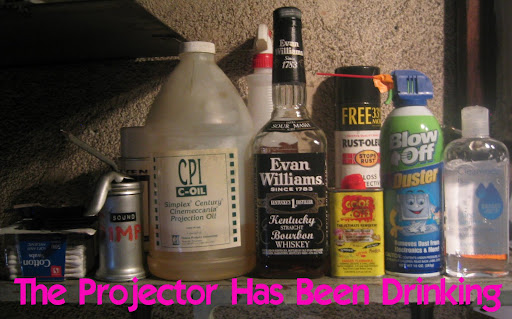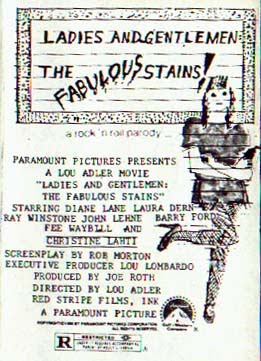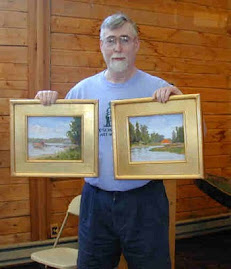There has been much divided reaction to Martin Scorsese's film adaptation of SHUTTER ISLAND, especially among my valued correspondents.
Sinamatic Salve-ation's Ariel Schudson
praises its authentic recreation of the failure of post-WWII mental health treatment, while
Phantom of Pulp's Mark Savage
grew weary of what he felt was its overreliance on dream sequences. I will come back to his observations later on, because they inspired my desire to post this essay - not so much a retort but a reevaluation.

For those who have not yet seen the film, I highly recommend it. Though Scorsese's body of work does not openly belie a leaning to what is classified as horror cinema, horror films have always been an influence on his style. And on multiple occasions, he has cited his affection for the steady output of England's
Hammer studio, which, alongside their iconic series of Dracula and Frankenstein tales, turned out a steady stream of what were called "mini-psychos": thrillers like PARANOIAC, NIGHTMARE, HYSTERIA, structured to provide the same gamesmanship and surprise of Hitchcock's 1960 masterpiece (though in actuality, most of the plots of these films share a closer kinship with Henri-Georges Cluzot's
LES DIABOLIQUES, a film that had almost been directed by Hitchcock). SHUTTER ISLAND, on a primal level, captures that grand atmosphere of looming dread, distrust, and disconnection.

By now you have likely heard a lot of moaning that the "twists" of the film are easily predictable, especially if you were repeatedly exposed to the too-revelatory trailers. (I personally avoided them for months) Let's get something straight right now: Hitchcock, and his best imitators (Brian DePalma, Neil Jordan, David Mamet), have never made the "twist" the most important part of their story. This misconception was no doubt popularized, ironically, by Hitchcock himself, on his long-running "ALFRED HITCHCOCK PRESENTS" TV anthology series, almost every episode ending on a stinger. It is the
aftermath of that twist upon the characters and the audience that they enjoy exploring, that is why in most cases, those surprises pop up in the
middle of the film, not the end; you start the movie knowing less than the characters, and finish knowing more, wondering
how this surprise is going to change them. Let's straighten another detail: if there was ever a filmmaker who is not only sure, but nay,
hopes, that you've seen a bunch of movies and know the storytelling tropes, it's Scorsese. He knows you're smart and that you could solve the puzzle, heck he's counting on it. As such, yes, I figured it out early, but I was still engrossed in seeing how
DiCaprio was going to figure it out. So regardless of how much you know or think you know about the plot, there will be plenty to entertain you.

In Mark Savage's negative review, I was caught by one of his statements:
I prefer waking nightmares. It's a great sentence, and I'm in agreement with it. Now, on the immediate topic, I would argue that one man's dream sequence is another man's unreliable memory bank, so yes, while there plenty of moments where DiCaprio is not getting a proper night's sleep, he's not exactly spending his waking hours with a clear vision either. And it's not like Scorsese is lifting from
Nick Reve's style book and
gratuitously putting a dwarf into the scene; all the horrific and bizarre images do have a logical, if not quite linear, place in the resolution of the story. But Mark's statement tapped into something bigger that I had been contemplating after seeing the film, an earlier waking nightmare also captured by Scorsese...
And here there be large spoilers...

In 1999, lost among the crunch of outstanding movies released in the fall period alone (FIGHT CLUB, AMERICAN BEAUTY, THREE KINGS, THE INSIDER), was another story of an authority figure trying to do his job while distrusting his partners, surrounded by unstable strangers, wary of doctors, plagued by hallucinations, and carrying guilt for deaths in which he was directly involved, also based on a popular best-seller.
BRINGING OUT THE DEAD was Scorsese's first project for Paramount, and more so than any of his other films is the perfect co-feature for the inevitable
New Beverly Cinema revival, not just because it will be easy to get both movies from the same studio.
Now, guilt is as constant a presence in a Scorsese film as
"See You Next Wednesday" is in a John Landis film. And SHUTTER ISLAND is not the first time Scorsese has paid homage to Hammer or dramatized the notion that the beast what scares us most is us: his terrific "AMAZING STORIES" episode
"Mirror Mirror" has that distinction. But there is a unique parallel in the structure of BRINGING OUT THE DEAD and SHUTTER ISLAND that make them special, and both of them waking nightmares.
"Ever notice people who see shit are always crazy?"
Cage's Frank Pierce and DiCaprio's Teddy Daniels are good souls who have been battered by spending too much time in the trenches, figuratively and literally. Frank's reputation as a paramedic was so good he was called "Father" Frank, as if he had powers imbued from God; Teddy has WWII service and was present at the liberation of a concentration camp, so he is a de facto war hero. But they themselves do not believe themselves heroic; Frank because he was not quick enough on the scene to save a young girl from a sudden deadly asthma attack, Teddy even more so because he arrived at the camp too late to save Jewish prisoners from being killed by the Nazis, and in domestic life years later, arrived home too late to save his children from being killed by his own unstable wife. Frank is now only barely functional, given to reckless behavior on his night shifts (though compared to his three successive driving partners, he appears sane). Teddy has completely broken, killing his wife in anguish and in the midst of psychiatric committment, creating a fictional alter ego who can take the blame for all his failings so that he can believe himself still "good." Heck, they each even have their own hard-tack with a badge that's always hassling them, threatening either to take off their sunglasses or bite their eyes out. And that eye fixation in both movies is only slightly coincidental - both protagonists have
seen too much to have any chance of normalcy anymore.
"Taking credit when things go right doesn't work the other way."
What contributes to the mental troubles of both men is, bizarrely, the establishment's willingness to
forgive them, when they cannot forgive themselves. Frank's partners have their manner of staying detached from the pain of failing to save a life, and the doctors they deal with are practically numb, often turning patients away or coldly pronouncing death over the phone. Teddy has committed a capital crime, but everyone feels sympathy for him because to them, it's so clearly the result of witnessing unspeakable horror in war and at home, and are thus bent to "cure" him so that he can ostensibly start over again. There are selfish motives too - '80's Gotham is short of capable paramedics, '50's Boston would love to have one of their better mah-shalls back on the job - so if they can be kept working, the powers that be will benefit.
"The streets are not like the ER. There's no walls, no controls."
These damaged men, meanwhile, wander about in a damaged environment. Teddy is a literal inmate given run of the asylum, and even in his delusional cop state, he can see that his doctors' notions of how to cure mental problems is failing. Besides, when the most fundamental authority figure in one's life - the mother - cannot be trusted to protect life, it's not hard for Teddy to believe the doctors are betraying him either. Frank's asylum is the whole of Gotham, a topsy turvy place where prostitutes are indistinguishable from housewives, the same old drunk has to be taken to the hospital every night, and a father who should have died peacefully at home has been defibrillated back to vegetative life
12 times in one weekend. And each world offers the men convenient red herrings to assign blame to - Frank repeatedly sees OD cases from a new strain of heroin called, appropriately, "Red Death," while Teddy rattles off paranoid theories about mind control and human experiments - and while these dangers are real, no question, sadly for them, they're not the tidy solution to their troubles; it's larger and messier than that.
"Tell me that's a crazy person! Every move is calculated!"
Finally, both stories tease a non-tragic ending for their characters, but ultimately take an ambiguous detour. Teddy, fully briefed on the extended roleplay exercise the doctors have staged for him, is taken to be lobotomized while leaving his primary handler uncertain to whether he had failed to reconcile his divided psyche, or worse, was cured but chose to be lobotomized anyway to erase his guilt. Frank, on the surface, seems like he has survived his three-day work ordeal, but considering that he has taken his nascent God complex to the next level, by directly choosing who to save (Noel the homeless man, Cy the drug dealer) and who to let die (the comatose father), when he beds down to rest with the now-deceased father's daughter, who does not know he pulled the plug on him, one is also left to wonder if he also has chosen an extreme measure to purge his guilt.
"No one asked you to suffer. It was your idea."
Two outstanding waking nightmares, courtesy of one master filmmaker.
 To be clear, it's not unpleasant to do special features for a bad movie. In fact, it's often fun depending on the demeanor of the participants. When I was enlisted to moderate commentary for the previously unreleased (for good reason) horror comedy NIGHT OF THE DRIBBLER, it gave me the pleasure of trading goofy impressions and corny jokes with veteran comedian Fred Travalena, and it was a thrill to go round-to-round and hold my own with him. In retrospect, as none of us at that recording session were aware of his ongoing fight with non-Hodgkins lymphoma which would ultimately claim his life four months later, I was darned lucky and privileged to have my role in what would be one of his last public speaking events. Yeah, in all candor, the movie is about as funny as a hangnail, but if you listen to my commentary, you'll find yourself laughing for all the right reasons.
To be clear, it's not unpleasant to do special features for a bad movie. In fact, it's often fun depending on the demeanor of the participants. When I was enlisted to moderate commentary for the previously unreleased (for good reason) horror comedy NIGHT OF THE DRIBBLER, it gave me the pleasure of trading goofy impressions and corny jokes with veteran comedian Fred Travalena, and it was a thrill to go round-to-round and hold my own with him. In retrospect, as none of us at that recording session were aware of his ongoing fight with non-Hodgkins lymphoma which would ultimately claim his life four months later, I was darned lucky and privileged to have my role in what would be one of his last public speaking events. Yeah, in all candor, the movie is about as funny as a hangnail, but if you listen to my commentary, you'll find yourself laughing for all the right reasons.
























